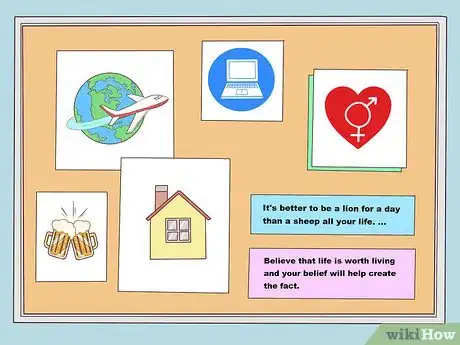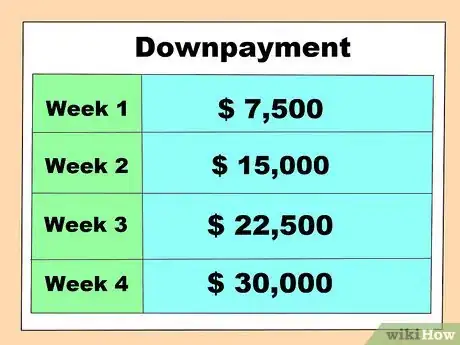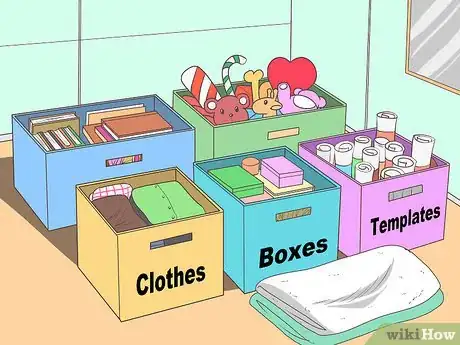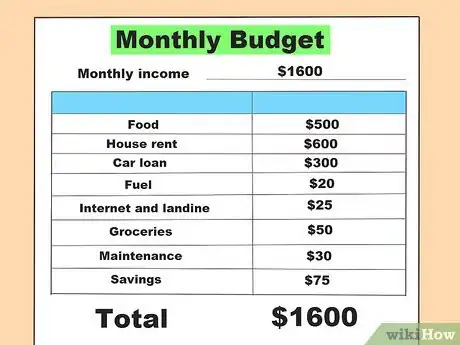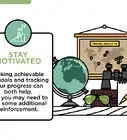This article was co-authored by Trudi Griffin, LPC, MS. Trudi Griffin is a Licensed Professional Counselor in Wisconsin specializing in Addictions and Mental Health. She provides therapy to people who struggle with addictions, mental health, and trauma in community health settings and private practice. She received her MS in Clinical Mental Health Counseling from Marquette University in 2011.
wikiHow marks an article as reader-approved once it receives enough positive feedback. In this case, 90% of readers who voted found the article helpful, earning it our reader-approved status.
This article has been viewed 513,190 times.
Are you feeling stuck in a rut or unhappy with your current situation? If you're interested in learning about ways you can reinvent yourself, harness your true potential, and change your life for the better, read on.
Steps
Visualizing Your Future
-
1Take inventory of your life. In order to figure out what you need to change, it’s helpful to take stock of your current situation. To get a sense of which pieces of your life you want to recreate, ask yourself a series of questions, and use the answers to help you decide what needs to change. Start by asking:[1]
- Are you mostly happy or mostly sad?
- How is your self-image? Do you feel healthy and fit?
- Are your relationships healthy or toxic?
- Do you have dreams and goals, or do you just live day by day?
- What do you value most and what’s important to you?
- What roles do you have to balance?[2]
-
2Visualize your ideal life. Sit down in a quiet place and close your eyes. Once you’re comfortable and calm, try to picture your ideal life. This might mean envisioning people or circumstances that you want to leave behind. [3]
- While you are visualizing, you might choose to concentrate on a feeling that you want to create, such as peace or love.
- You can also try to picture a particular circumstance, such as an exciting new career.
Advertisement -
3Write about your new life. Once you have a vision, put pen to paper. Writing about what you want can help make it seem more concrete. Take some time to write about the things and feelings that you want in your recreated life. [4]
- Choose a writing style that works for you. You can make lists, create detailed scenes, or even write dialogue about the way you imagine your new life playing out.
- You might write about a scene where you nail an interview for your dream job, for example.
-
4Create visual reminders of your goals to keep them in sight. To do this, you can use pictures or objects that represent the changes you want to make. For example, if you want to move to California, you could keep a map of the state in your car. [5]
- You could also create a vision board where you gather images. You might pin a picture of a house you like or someone you admire. You could also put applicable quotes and sayings.
Making Concrete Goals
-
1Write down long-term goals. In order to make your vision reality, you need to have tangible, realistic goals. Break down the things that need to happen in order for you to recreate a part of your life. Start with the big picture, long-term goals. [6]
- For example, if your goal is to buy your dream home, you might write down that you need to save $30,000 for a down payment.
- If you envision yourself in a totally new career, a long-term goal might be to finish the educational requirements you’ll need to get into that field.
-
2Make a list of short-term goals. Once you have your big goals, write down the smaller goals that you will need to achieve to reach them. Short-term goals might be things that you do on a daily basis or things that you do weekly or monthly for a period of time. [7]
- If you are saving for a down payment, create a short-term goal of setting aside a certain amount of money each week.
- If you’re looking to change careers, a short-term goal might be getting your resume in order.
-
3Track your progress to keep your spirits up. When you’re making a major life change, you’re bound to experience setbacks. That’s okay! The important thing is to stay optimistic. Keep track of all of your progress towards achieving your goal. When you hit a bump in the road, look back at what you have accomplished instead of focusing on your setback. [8]
- For example, maybe your cat had to go to the vet and you did not meet your savings goal for the month. Look back at your records and say, “That’s okay, because I was able to save a little extra last month. And I can put aside a little next month, too.”
-
4Reassess your progress at regular intervals. Set aside some time each month to evaluate your progress. Take stock of how well you are doing, and note whether or not you need to make changes.[9]
- Maybe you are trying to become a professional dancer, but you haven’t been able to book any jobs. You might decide that you need to take 2 additional dance classes each week to speed up your progress.
Adopting a Positive Mindset
-
1Learn to be more mindful. You can be more mindful by paying more attention to your surroundings. Train yourself to take time to notice how things look, smell, and sound. You might take time to notice a gentle breeze as you walk to work. Mindful people are thought to live happy and productive lives. [10]
- Try meditation to help achieve mindfulness. You can start by just sitting quietly and clearing your mind for 5 minutes. You can also download apps that have guided meditations.
-
2Connect with people everyday. Improving your quality of life can make you feel refreshed and renewed. One way to do this is to much sure that you have some positive human contact each and every day. This is especially important for people who spend a lot of time alone, such as those who work from home. Some ways to connect are: [11]
- Giving someone a hug.
- Calling a friend.
- Striking up a conversation with someone at a coffee shop.
- Eating lunch with a coworker.
-
3Read and listen to podcasts to expand your knowledge. Knowledge really is power! The more you know about the world, the more likely it is that you will feel engaged and happy. You don’t have to dwell on political drama, but make it a point to read a few news articles most days of the week. This will also help you to make interesting conversation with others.[12]
- Podcasts are a great way to stay up to date and learn new things. You might choose to listen to a current events show, or one about something you’re interested in, like cooking.
- Read books about people you admire to learn about their mindsets.
-
4Practice gratitude daily. Adopting a gratitude practice can make you feel more positive about your life. Get in the habit of thinking of at least 1 thing that you are grateful for each day. You can do this when you wake up, before you go to bed, or anytime in between. You might think, “It’s cold out today, but I’m grateful I have a warm home.”[13]
- Record your thoughts in a gratitude journal so that you can look back and reflect from time to time.
-
5Contribute to your community by giving time or money. Not only will you help others by volunteering, but you can also really boost your sense of self! Look for an organization that you feel passionate about and inquire about ways to help. If you’re an animal lover, for instance, contact a local rescue organization. [14]
- If you don’t have time to volunteer, ask about making a financial contribution. It doesn’t have to be much! Any little bit can help.
Living a Healthy, Productive Life
-
1Organize your surroundings to feel less stress. Give your life a makeover by getting organized! Start by rearranging your physical space. No matter what time of year it is, do some spring cleaning. Go through closets and drawers and get rid of items that you know longer want or need.[15]
- Make each area organized so that it is stress-free to try to find something. For example, organize your closets so that pants are together, skirts are side by side, etc.
- Do a mini-clean each night before bed. Take 10 minutes to put things away, wipe down counter tops, and just generally set yourself up for an easy morning.
-
2Develop a routine for a sense of consistency. With consistency comes a sense of calm, so develop a routine and stick to it. You can start by getting up and going to bed at the same time each day. It is also helpful to create a detailed schedule. For example, you could plan to walk your dog morning and night for 30 minutes. That way, that part of your day will become routine.[16]
- Create a bedtime routine that is peaceful. Choose something you enjoy to help you wind down in the hour before bed. It might be something quiet like reading or knitting.
-
3Care for your physical health with diet and exercise. Your physical health has a direct impact on how satisfied you are with your life. Make sure to care for yourself by eating a diet that is full of lean proteins, complex carbs, and fruits and veggies. Eat healthy snacks like almonds or hummus throughout the day to keep your energy up. [17]
- Aim to get at least 30 minutes of exercise most days of the week. Choose an activity that you enjoy, such as swimming, yoga, or hiking. You’ll gain energy and a clear mind, and get major health benefits.
- Don’t forget to care for your mental health as well. Meditate, practice yoga, and avoid stressors in your life.
-
4Set a budget and stick to it. Being financially healthy is important for a happy life. Taking care of your finances can also help you achieve goals, such as buying a home or feeling secure enough to switch careers. Figure out your income and your expenditures. This will help you know how much you can save and how much “fun money” you have.[18]
- You can use apps or websites such as Mint to help keep track of your finances.
Expert Q&A
-
QuestionCould it be possible for me to get a degree in my dream field if I am passed the maximum age limit?
 Trudi Griffin, LPC, MSTrudi Griffin is a Licensed Professional Counselor in Wisconsin specializing in Addictions and Mental Health. She provides therapy to people who struggle with addictions, mental health, and trauma in community health settings and private practice. She received her MS in Clinical Mental Health Counseling from Marquette University in 2011.
Trudi Griffin, LPC, MSTrudi Griffin is a Licensed Professional Counselor in Wisconsin specializing in Addictions and Mental Health. She provides therapy to people who struggle with addictions, mental health, and trauma in community health settings and private practice. She received her MS in Clinical Mental Health Counseling from Marquette University in 2011.
Professional Counselor Investigate whether the degree is available from another source. Also, self-directed learning can take place at any time and any place. For university-level reading, check into accessing the library of a college or university near you as a guest.
Investigate whether the degree is available from another source. Also, self-directed learning can take place at any time and any place. For university-level reading, check into accessing the library of a college or university near you as a guest.
References
- ↑ https://www.sharecare.com/health/wellness-healthy-living/how-take-inventory-my-life
- ↑ https://www.mindtools.com/pages/article/newHTE_93.htm
- ↑ https://tinybuddha.com/blog/5-steps-to-reinvent-yourself/
- ↑ https://tinybuddha.com/blog/5-steps-to-reinvent-yourself/
- ↑ https://tinybuddha.com/blog/5-steps-to-reinvent-yourself/
- ↑ https://www.psychologytoday.com/us/articles/201405/reinvent-yourself
- ↑ https://www.psychologytoday.com/us/articles/201405/reinvent-yourself
- ↑ https://www.psychologytoday.com/us/articles/201405/reinvent-yourself
- ↑ https://www.psychologytoday.com/us/articles/201405/reinvent-yourself
- ↑ https://www.themuse.com/advice/16-small-ways-you-can-improve-your-life-in-less-than-30-minutes
- ↑ https://www.wanderlustworker.com/25-habits-for-improving-the-quality-of-your-life/
- ↑ https://www.wanderlustworker.com/25-habits-for-improving-the-quality-of-your-life/
- ↑ https://www.wanderlustworker.com/25-habits-for-improving-the-quality-of-your-life/
- ↑ https://www.wanderlustworker.com/25-habits-for-improving-the-quality-of-your-life/
- ↑ https://www.themuse.com/advice/16-small-ways-you-can-improve-your-life-in-less-than-30-minutes
- ↑ https://www.themuse.com/advice/16-small-ways-you-can-improve-your-life-in-less-than-30-minutes
- ↑ https://www.themuse.com/advice/16-small-ways-you-can-improve-your-life-in-less-than-30-minutes
- ↑ https://www.wanderlustworker.com/25-habits-for-improving-the-quality-of-your-life/



